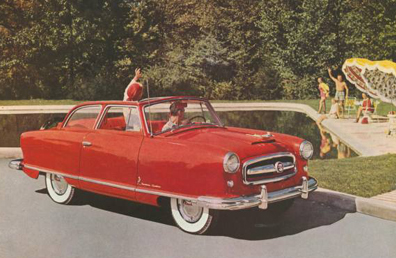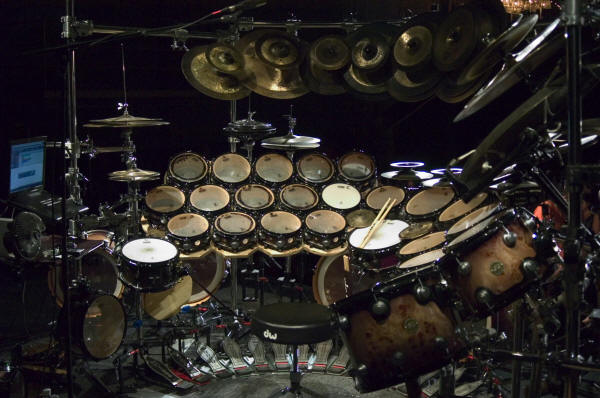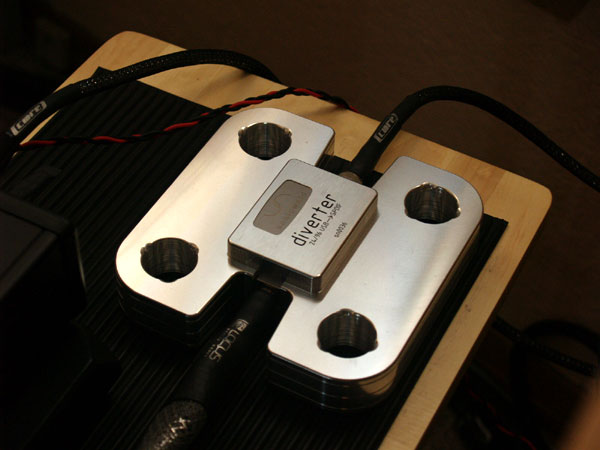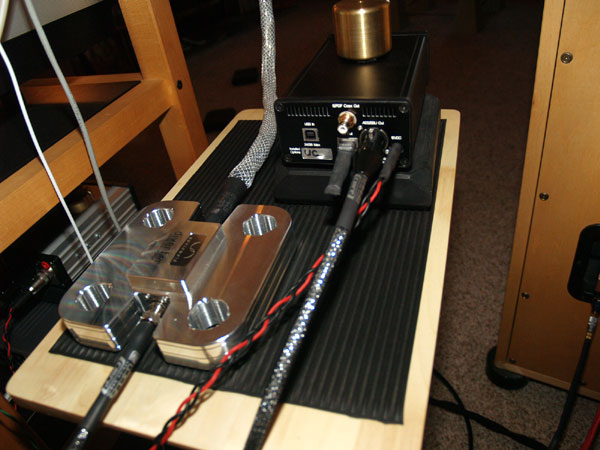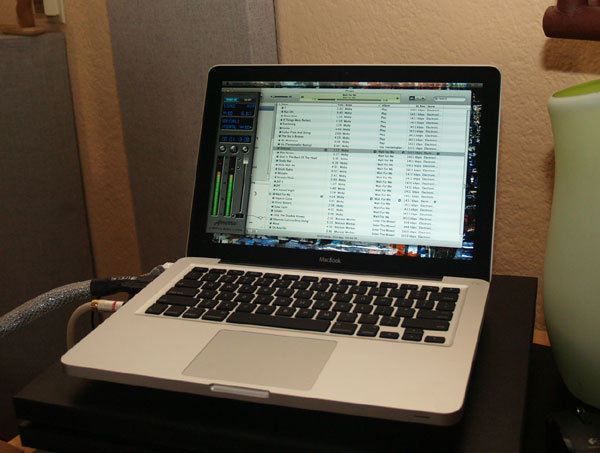|
You are reading the older HTML site Positive Feedback ISSUE 46november/december 2009
Audio Ramblings - some
real ramblings and then onto the USB Diverter from Sonicweld,
the Cynosure USB cable, Amarra, and more...
A true case of audio ramblings…. I just love questions like, "Which is the best power conditioner?" And even better yet, the responses that such an inquiry might generate... "I own product A because some people said it was the best and it sounded really good here, but a friend brought over product B (he owns it because other people said it was the best and it sounded really good there) and when we inserted it into my system it was way better than product A, so I sold product A to another friend who has product C because product A was better than product C in his system, but out of curiosity I borrowed his product C (that he owned because people said it was the best and it sounded really good there) and golly gosh gee, in my house product C was better than product B! So I offered him product B to try because it was way better than product A here—but not as good as product C—and at his place it didn't sound really all that much better than product C. Different, but he liked them both." Of course there are the outlying responses of… "I tried A, B, C and they all sounded so bad when compared to going straight into the wall!" And of course, "I also tried A, B, and C, and compared to D they all suck!" So which is the best power conditioner? Uh… well, they all are quite excellent, but the issue is different grids—meaning different AC pollutants; and different systems—meaning different ways that said AC pollutants interact with the components; along with different wants and 'needs' by the listener(s) as they listen to what said products either do, or don't do in a system. So saying that product A, B, or C is the clearly best is simply, well… is simply BS. Sure it can certainly be the best in a specific situation (within a specific system on a specific AC grid and at that specific time in the day) but is it the best in all other situations? Some certainly, many possibly, but all… very unlikely.
AC pollutants change over the course of the day, so how one product deals with pollutant A (extremely well), pollutant B (somewhat well), and pollutant C (not really well at all) will differentiate it from another product that deals with pollutant A (not so well) and with pollutant B (quite well) and pollutant C (extremely well) all with respect to how these pollutants then affect the components being feed the polluted AC. Component A has issues with pollutants B and C, but is immune to pollutant A while component B has issues with pollutants A and C, but is immune to B, while component C has issues only with pollutant B and is immune to A and C. Go over to another guy's house and it is more different than the same based on his components and any and all pollutants riding on his AC. In the end it is all about the situation (the compatibility, synergy, etc. of the whole system and grid), along with the listener's impressions, interpretations, preferences, etc. of what they are listening to. There are no absolutes. What works for me may or may not work for you—and vice versa. So if someone says that this beast the crap out of that… well, it all depends when and where. You got to try before you buy so tell everyone else to shut the f#@k up when they say that A is better than B! This is also related to cables, amplifiers, speakers, etc. Yeah, what works for me may or may not work for you. Sure, I loved it and this is way better than that… and heck it is the best I have ever heard, but will you feel the same? Maybe… possibly… but then again, probably not. Which does not mean that there is no value in sharing information or experiences; one can learn a lot from what others have learned, but that is all it is, nothing more or nothing less: their unique experience and it ain't going to be universal. So, if anyone claims to be the fountain of all audio knowledge—kneel my son and I will enlighten you as to the truths of all-things-audio—well I would be cautious when imbibing in their fountain of Kool-Aid. In the end it is what works for you and that is all that matters… don't let anyone tell you otherwise. There are no absolutes in audio… except that there are no absolutes in audio. No absolutes you say? What about the absolute as in the philosophy of the existence of an absolute sound and then recreating it on one's home? Isn't that what this audio pursuit thing is all about? Yeah right… please explain how a unique experience (in terms of emotional state, time, and place) can ever be recreated in totality somewhere else and at a different time and under a different emotional state via some recorded medium? You simply can't do it. Period. Time has moved on, the event has come and gone, and you are most certainly in an emotionally different state than you were prior at said event. Sure you can get a semblance of the event by either transporting you there or it here in your room by presenting something that reminds you of what you have heard before, and in many ways be very close to the original experience, but to strive for the actual thing… seriously now, it is a recording. Same place? No. Same time in space? No. Same mental state? Same mind altering whatever? No… well maybe if you got it really going again but the same actual event? Uh, obviously not and that is the real deal breaker. Anything you play back is simply the recording of that event… it is not the event, but simply the documentation of the event. And when I say event I do not necessarily mean a live event, but any event that defines a musical incident (studio, live, etc.) that has been saved on some medium for playback. Besides, unless you were actually there you have no idea of how it was supposed to sound… of which is a whole 'nother issue. My interpretation, my location, and my emotional state will all be different from yours—so at best it is my idea of the absolute and not yours… or your idea and not mine! Of which both are quite valid, but then it ain't an absolute is it? I mean, how is it an absolute if we all have a different interpretation of what the absolute is? To me at least, that is counter to the definition of an absolute. Yes, absolutely! Okay, sure I know what a drum sounds like, a guitar too. Whatever, yeah I have heard it before in person in various situations so I am pretty sure that this is that and not something else on a recording unless that was the intent (that would be making electronic drums sound like real drums). But in the end, when I play something back, I either like it or I don't. I have really no idea if the recording truthfully captured the instrument or the event (make that absolutely) as I wasn't there, though it may certainly sound quite real and wonderfully right. That is, it sure sounds good, and yeah, it sure sounds what I think it should sound like, but is that what it really sounded like… then and there?
The drums sound like drums, but do they sound exactly like the drums sounded there—that is "the absolute sound a real instrument in a real space"? No clue, wasn't there… and besides would the same drum sound the same played somewhere else at a different time? Uh... no. So what is the absolute sound here in my home with my system? The best I can get is that, either I like what I hear here and therefore I connect to that sound or presentation and like it, or then perhaps they don't and so perhaps then I don't. But the absolute sound? No idea. But it sure sounds good here… that is things sound mighty close to what I want them to sound like. But are they real… uh, no. Don't get me wrong, recreating an absolute sound certainly is noble endeavor, but it ain't going to happen anytime soon. Do we have that capability with the recording chain… with the playback chain… with our room? Not really, quite unlikely, don't think so. Microphones do not pick-up sounds as our ears do and speakers do not expel sounds out into a room as a real instrument does… so perhaps someday, maybe, but in the end who cares? Either you like it or you don't. You either connect to it or you don't, so it either works for you or it doesn't. Case in point, I have a friend in the industry that was fortunate enough to attend a performance that was recorded with the best of the best by one of the top names in the industry. He was there and heard the event in person in, but in listening to the playback (via master tape, LP, or SACD) on various SOTA systems, no way… not even close to the live experience. Nice, but no cigar. Yeah it reminded him of the event; the instruments sounded like they sounded to him in person, but it wasn't real, just a facsimile of what had occurred only days prior. This is kind of like searching for the Holy Grail… a mythical pursuit at best. For me at least, all one can do is to figure what you want from your system; that is, what do you like, what you want your music to sound like (that is what you think it should sound like), and then go from there in getting whatever is on or in the recorded your choice of medium to represent what you like. So stop chasing your tail, sit back and enjoy… sure it can always be better, but then that is what the pursuit is all about.
And now onto the meat of the meal… the USB Diverter from Sonicweld. Just so you know, this is not going to be a full review, just an intro of sorts about the newest USB/SPDIF converter on the block. I am going to make the Diverter a continuation (along with the Empirical Off-Ramp 3 as I get more converters in house). The Diverter is the child of Josh Heiner of Sonicweld with much prodding by Lee Weiland of Locus Design and in many ways bucks the trend in how to get things done. Josh is a fanatic at engineering things right, and by right I mean right in terms of what will work best in a specific situation with no shortcuts or tradeoffs when it comes to the choice of the right parts, for the right design, and the overall right implementation of it all to do exactly what it needs to do… with no concessions to popular trends or whatever. For example Josh choose to power the Diverter by the USB from the computer… what you say, that is simply audio blasphemy! USB power is crap… you got to an outboard power supply or at the very least batteries! Its crap I tell you… it won't work… and yet it does quite nicely. Actually, very wonderfully satisfactorily indeed. How so? (BTW, here are two links where Josh gets into why he went that route, so check them out: http://www.head-fi.org/forums/6049287-post100.html and http://www.head-fi.org/forums/f46/usb-24-192khz-m2tech-hiface-446375/index9.html). After reading this it is clear that going the way he did makes sense on all counts.
Well, when compared to an Empirical Off-Ramp 3 with the Ultraclock upgrade which is being powered by a Paul Hynes regulated power supply which is then tethered by an Audience 'e' powerChord to the Audio Magic Transcendence AC conditioner, well the two sound so similar to each other—warm, liquid, musical, naturally resolving, detailed, dynamic, dimensional, etc.—that I could live quite happily with either, except the Diverter just seems to dig a bit deeper in all the areas I so desire. That is the music has just a touch more dimensional realness to it along with a coherence and liquidity that makes vocals and whatnot sound more like what I think they should sound like. The Diverter presents music as being smoother and yet more resolving, with a touch more there-ness to it. The best way to put this is that the Empirical compared to the Diverter reminds me of the differences heard with the Hynes PSU and the BPT battery PSU. The Empirical has more of the qualities heard from using the battery PSU and the Diverter has those more representative of the regulated Hynes PSU. The Empirical is a bit fuller, softer, and rounder with less delineation in the bass while being a bit warmer and less resolving overall. The Diverter is a bit more viscerally incisive or better yet, incisively detailed with a more delineated bass and relevant dynamics and slam. Along with all that, the Diverter has more musical punch with a presence that extends further out into the room. It propels the music with more control and decay than the Off-Ramp does with tracks featuring well-recorded bass and drums. Very cool and at $1295 when compared to the Off-Ramp 3 set up as I have here ($699 for the basic Off-Ramp 3 plus $800 for the Ultraclock, around $500 for the Hynes SR3-12, and $650 for the Audience 'e' powerChord… making that a total of $2650) the Diverter is a steal. Both handle 24/96 and require no drivers to be installed to work, nor have I have had any glitches with either.
Of course there are few advantages to the Off-Ramp 3 set-up: 1) it allows for either AES/EBU or RCA S/PDIF connections; and 2) you can really tune or voice it with different AC cords and power supplies. Meaning for the greatest flexibility the Off-Ramp 3 is number 1. On the other hand, the Diverter only has a single BNC connection (meaning you either need a cable terminated as such or an adaptor; the adaptor is included free of charge) and what you see is not really all that you get; that it is not just another black box but a gorgeous hunk of milled 6061-T6 solid billet aluminum alloy combined with stainless steel constrained layer damping plates and that there is more to the Diverter than just this pretty exterior… like a custom silver-plated six layer circuit board with multiple ground and power planes populated with the best non-microphonic bypass film types caps, extremely short signal paths (all signal paths), low-ESR bulk capacitance attached directly to power and ground planes, multiple, aggressive stages of filtering, three separate supplies using the lowest-noise regulators on the market, and three, large multi-element, computer-optimized bypass networks that connect directly across the power and ground planes, and a low-jitter master oscillator with ultra-short clock delivery path that Josh suggests makes the USB input choice to be rather irrelevant as long as the jitter at the output is excellent (Josh is more into "what kind of jitter is present and not simply the amount of it" sort of designer and so apparently the output of the Diverter is very, very good in terms of jitter measurements—Josh promises to have something for me in Part 1. But is it as good as the Empirical Off-Ramp 3 which has addressing jitter clearly in its cross-hairs? Got me, but both sound quite good regardless of how they deal with jitter or how the USB input is dealt with.) I used the Diverter with the Locus Design Core BNC/RCA digital cable($749 for up to 3FT, $75/FT thereafter) and the Cynosure USB cable ($2849 for up to 3FT, $320/ft thereafter)—both as good as I have heard. To make things as equal as possible, I used an AES/EBU Core digital cable so I was comparing apples to apples. All I needed to do is hit pause in iTunes (9.0.2) or Amarra (3189), swap the USB cable from to the one to the other, then change the input on the Playback Designs MPS-5, and back and forth we went. If I didn't mention this above then let me say it now, any differences between the two are rather nil in terms of overall tonality and getting the music across to the listener. Where the Diverter stood out was in overall smoothness (a lack of grain and grit—it just sounded that much cleaner especially with respect to vocals), and presenting the music more righter in terms of dimensionality, overall definition (clarity and presence), and cohesiveness. It is just that much more engaging than the wonderfully sounding Off-Ramp 3 set-up (as I have it configured here) in how it presented the music overall. But either USB converter is a clear winner and no doubt in a different system the results will be, well… different.
Okay, enough on the Diverter, after all this is supposed to be just an introduction. So let me back up and say that the Cynosure is clearly a step up from the Nucleus ($$1149/1-3ft, $120 each additional foot) in all areas: bigger, more resolving, warmer, more real and tonally richer… and way more dimensional. Wow, this USB cable is not only the cat's pajamas but the slippers and lounging robe as well! Way elegant and chic in all respects, but ridiculously expensive. Lee, you're killing me man! As good as I found the Nucleus, the Cynosure moves the SOTA standard well down the road, but at that price it had better. Which then begs the question, is it worth the $2850? I don't know man, that is a hell of a lot o' money, but Lee assures me that the materials, time, and effort that goes into making the cable justifies the price—it ain't an easy or simple build, so… it is not something I could afford, but yeah, it is very, very good. In the end, only you can decide if the cost is worth it… the problem is once you hear it, it is hard going back! And then there is the way 'affordable and what a deal for the money' Core digital cable. Yikes, this cable is stellar and easily competes against other digital cables (like the $850 PAD Aqueous Anniversary Digital Cables and the $1095) in every way. Musical as all get out and highly recommended.
And then there is the Amarra playback software, which is not something that is an easy back-and-forth revelation. No, it takes time listening while not really listening. Amarra allows for more dimensional palpability and an overall presence rich in the delineation of individual instruments. The music just has a better feel to it than with iTunes. But it doesn't jump out at you in a quick back-and-forth. You'll appreciate the differences if you are more casual about it… then the old, "How about now?" "Now?" "Okay now?" "How about now?" "Now?" "Okay now?" "Now?" No you got to listen to iTunes for several days and then change to Amarra for the differences to reveal themselves. It is all about the subtleties in the music… there are no big discrepancies here for me to experience as both are tonally quite similar and engaging… I guess the best way to put this is that Amarra has many of the same qualities that I hear with the Diverter. Amarra is just righter in the key ways that allows for the music to just happen. It works, but the differences here are not as revelatory as heard by others in their own systems. Why I have no idea (others who have heard night and day differences don't hear 'em here either, so it ain't just me). For me at least the differences only reveal themselves over time… but more on all this next time.
Oh, wait. You have got to try one of the PAD Digital Isolation Adapters on the RCA S/PDIF end of things (blue circle above). Adding this to the end of the digital 'input' chain makes images more solid while allowing for a larger and more dimensional soundstage to really open up in the room. I hear more of what is going on with less smearing and whatnot getting in the way of the music. Sort of a "didn't know I needed it till I tried it" sort of thing. Sounded really nice before and sounds even nicer after. Using it with the Diverter and Sure cable, and wow, it moves everything up a notch or two in terms of what I said above about the Diverter. More on this too… Cryo Parts (Diverter) http://www.cryo-parts.com Amarra http://www.sonicstudio.com Purist Audio Designs http://www.puristaudiodesign.com/ Locus Design (Cynosure) http://locus-design.com Locus Design (Core) http://locus-design.com
|

